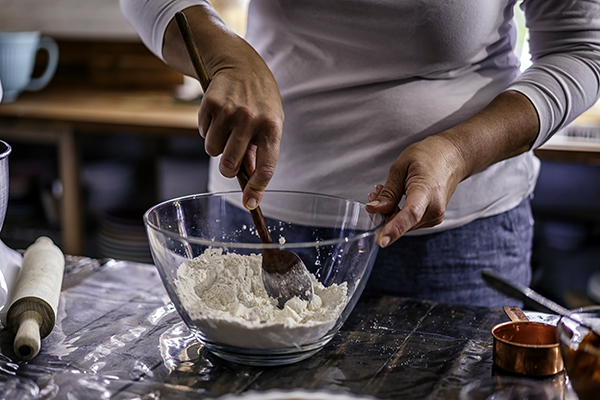Gluten-free flour is flour that does not contain gluten, a protein found in grains like wheat, barley, and rye.
In baking, gluten acts as a binder that helps foods hold their shape, adds elasticity, and helps dough rise.
Imagine a baguette, with an oven-crisp crust on the outside and a chewy, craggy middle.
Gluten traps gas bubbles during fermentation, which gives that baguette its unique texture. Without gluten, bakers often rely on a blend of different gluten-free flours to achieve the same results.
Do you need gluten-free flour in your diet? It depends.
“Unless you have celiac disease or a true gluten sensitivity, there may not be benefit in eliminating it,” says Frances Arnold, R.D., owner of Namaste Nutritionist.
Keep reading for all the need-to-know details about gluten-free flours.
1. Rice flour
One of the most common gluten-free flour substitutes, brown rice or white rice flour is gluten-free naturally.
This delicate, neutral-tasting flour is ideal for baking, in pancakes, and as a coating for chicken or fish.
Combine rice flour with one of the higher-protein flours listed here to add structure.
2. Bean flour
Dense, sturdy, and filled with fiber, bean flours are common in gluten-free pastas. Use chickpea flour in baked goods like gluten-free pumpkin spice donuts, tortillas, or pizza.
Black beans pair surprisingly well with chocolate and the bitter notes of coffee.
3. Lentil flour
Milled from sprouted or unsprouted red, yellow, green, or brown lentils, this gluten-free flour imparts a mild, nutty flavor.
It’s also an excellent source of protein (26 grams per 100-gram serving) and iron (6 mg), as well as a good source of potassium, with 686 milligrams of that essential mineral.
When baked, it can add a pleasant crispy-crackle ideal for gluten-free crackers.
4. Pea flours
Green pea flour and pea flour are high in protein and similar to bean flour in how they perform and taste.
The protein content adds structure, but using too much could give your masterpiece a green hue — good for Frankenstein or shamrock cookies but not so much everyday breads and cookies.
5. Corn flour and starch
Corn is fantastic in tortillas, cornbread, pizza crusts, corn muffins, and Johnny cakes.
You can also use cornstarch as a thickener in gravy, soup, or stir-fry sauces in place of flour. Opt for fine cornmeal for baking, and save the coarser grits and polenta for a gluten-free side dish.
6. Millet and quinoa flours
These powerhouses add structure, so you might be able to skip other binding ingredients.
Millet has a more neutral flavor than quinoa, which can taste a little bitter to some palates. The solution? Toast the quinoa before you grind it, suggests Alyssa Rimmer, a food blogger at Simply Quinoa.
7. Oat flour
Oats and oat flour make the iconic cookie with raisins and a kiss of cinnamon, and it’s easy to grind your own at home.
You simply grind oats into a powder in a blender or food processor. Oat flour is fluffy, so mix it with some of the heavier flours for a more balanced texture.
Note when buying oat flour: While oats are naturally gluten-free, they are often exposed to gluten-containing grains during processing.
Look for certified gluten-free oats if that’s a concern.
8. Teff flour
A staple in Ethiopian diets, teff is a grain that’s an excellent source of protein (13 grams per 10-gram serving!), fiber (8 grams), and calcium (180 milligrams).
It adds a nutty note to cookies, biscotti, cakes, quick breads, and injera, an Ethiopian spongy fermented flatbread.
9. Nut flours
Coconut and almond flours are the most popular flours in this category, and they’re keto-friendly.
You can use 100% nut flours when baking, but the higher fat and protein content can yield dense results. Blend small amounts nut flours with other flours.
Almond flour is one of the ingredients in our favorite gluten-free banana bread.
10. Sorghum flour
Similar to wheat, this flour is dense in protein and comes in red and white varieties. Use in pancakes, breads, muffins, cookies, or spice cake.
11. Cassava flour
All the rage in paleo products, cassava flour is gluten-, grain-, and nut-free and made from the cassava root.
It’s a higher-carb flour, so it wouldn’t be ideal for keto recipes. Combine with almond flour to make killer grain-free tortillas.
12. Potato flour and starch
Potato flour is a fine powder made from dehydrated potatoes that can replace gums in gluten-free baking.
Don’t overdo it though — add 2–4 tablespoons per recipe to avoid gumminess. Potato starch can be used as a 1:1 substitution for cornstarch.
13. Seed flours
Flaxseed, chia seed, and hemp seed make nutrient-dense flour and thickener options.
Chia bloats when suspended in liquid, which is why it makes a great gum-free binder.
Hemp contains all essential amino acids, but keep in mind that the flour can be gritty.
Gluten-Free Baking Tips
Gluten-free baking requires more precision than baking with wheat flour. Gluten-free flours and mixes often contain a combo of different types.
Higher-protein ones add structure but can yield a dense product. Beans, starches, and oats contribute different tastes and textures.
Nut flours are higher in protein and fat, so they burn more easily. When using them, reduce the temperature by 25–50 degrees Fahrenheit.
Arnold also recommends covering with aluminum foil until the final 10 minutes to avoid over-browning.
Gluten-free flours may also require the use of a binding agent — the most common being xanthan gum.
To avoid gums, substitute psyllium husk, ground flax, or chia.
These tips can also help:
- Measure gluten-free flour carefully. Many types of gluten-free flour can get dense. Try a food scale for more precision.
- Mix your dough and batters thoroughly and let them rest. After mixing, cover the bowl with a clean towel and let it rest for 30 minutes to thicken.
- Rely on suggested bake or cook time vs. the toothpick method. Let baked goods rest before slicing to give the starches time to set and firm.




























